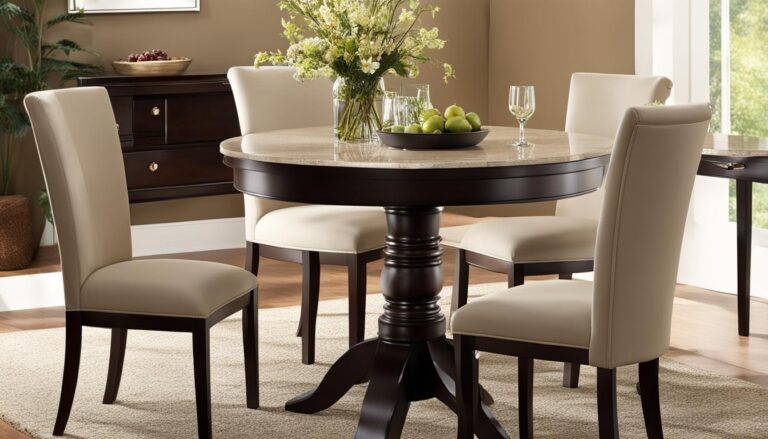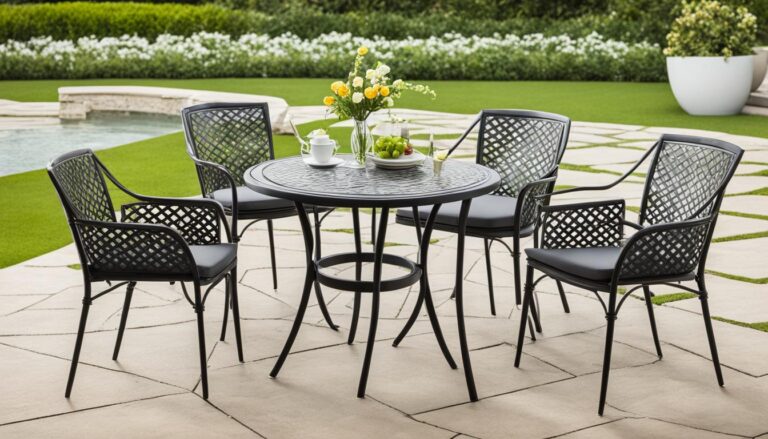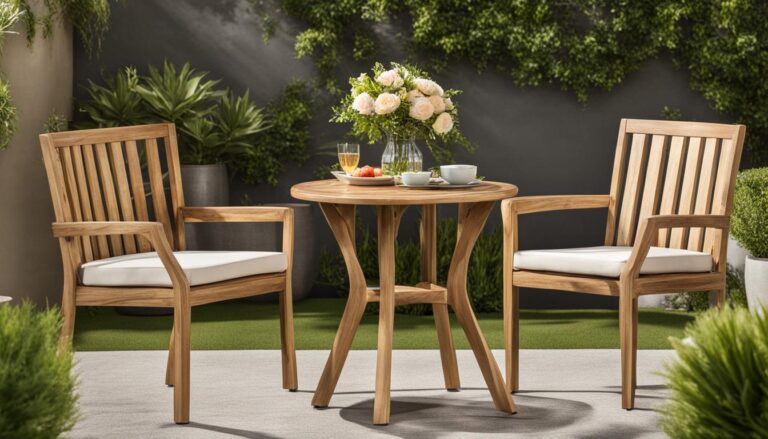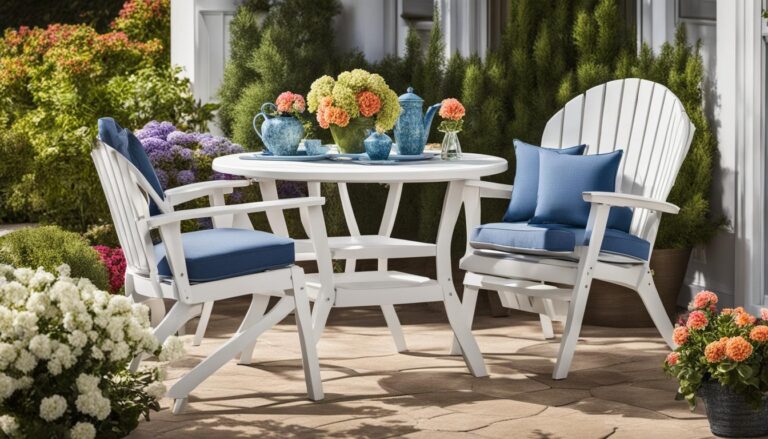Storing your patio furniture in the garage can be a smart and space-saving solution. However, it’s important to consider the type of furniture material and potential risks like temperature fluctuations and pests. By following the right storage methods, you can protect your patio furniture and make the most of your garage space.
Key Takeaways:
- Assess the risks before storing furniture in the garage, considering factors like material and vulnerability to temperature and humidity changes.
- Consider options like renting a climate-controlled storage unit for added protection.
- Clean your furniture thoroughly before storing it to prevent mold and mildew growth.
- Take apart furniture pieces to optimize space and make reassembly easier.
- Wrap furniture with appropriate materials for long-term storage to protect it from moisture.
Is It Okay to Store Furniture in the Garage?
When it comes to storing your outdoor furniture, the garage seems like a convenient option. But is it really okay to store your furniture in the garage? The answer depends on a few factors, such as the material of the furniture and the risks associated with garage storage.
Risks of Storing Outdoor Furniture in the Garage
If your furniture is made of wood, it is susceptible to damage from temperature fluctuations and humidity levels in the garage. Extreme cold or heat can cause the wood to warp or crack, leading to permanent damage. Upholstered furniture, on the other hand, can attract insects and odors when stored in the garage. This can result in costly repairs or replacement. Electronics should also be kept away from extremely cold environments to prevent damage to sensitive components.
However, if you take the necessary precautions, you can safely store your furniture in the garage. Consider the following garage storage solutions for patio furniture:
- Ensure the garage is well insulated and has proper ventilation to minimize the impact of temperature and humidity fluctuations.
- Place a dehumidifier or moisture absorber in the garage to control humidity levels.
- Cover your furniture with appropriate protective covers to shield it from dust, dirt, and potential pests.
- Elevate your furniture off the floor using pallets or other materials to prevent moisture damage in case of flooding or leaks.
| Material | Suitable for Garage Storage? |
|---|---|
| Wood | Not recommended due to susceptibility to temperature and humidity changes. |
| Plastic | Suitable for garage storage with proper cleaning and care. |
| Metal | Can be stored in the garage, but protect against oxidation with regular cleaning and maintenance. |
| Upholstered | Not recommended due to the risk of attracting insects and odors. |
By understanding the risks and taking appropriate measures, you can safely store your furniture in the garage and maximize your available space. Just make sure to choose a suitable storage option, clean and maintain your furniture, and protect it from potential damage.
Consider Your Storage Options
When it comes to organizing your patio furniture in the garage, it’s important to consider your storage options. Whether you have access to a garage or need to rent a storage unit, you’ll want to evaluate the costs and amenities that best meet your needs. If you have a garage, you’ll need to ensure it provides adequate protection against extreme weather conditions such as temperature fluctuations and humidity. If you decide to go for a storage unit, consider opting for a climate-controlled unit, especially if you have wooden furniture, delicate fabrics, or musical instruments that are sensitive to temperature and moisture changes.
In addition to protection, you’ll want to think about the space available. Take measurements of your furniture and check the dimensions of the storage units you’re considering to make sure everything fits comfortably. It’s important to give each piece of furniture enough room to prevent damage and allow for easy access. You may also want to consider the accessibility of the storage unit, especially if you plan on using your furniture regularly.
When deciding between storage options, it’s helpful to weigh the convenience, cost, and level of protection provided. By carefully considering your storage options, you can ensure that your patio furniture is organized, well-protected, and easily accessible when needed.
Compare Garage and Storage Unit Options
| Storage Option | Pros | Cons |
|---|---|---|
| Garage | – Convenient access – Cost-effective – Customizable space |
– Limited protection against extreme weather – Limited space availability |
| Storage Unit | – Climate-controlled options – Higher level of protection – More space available |
– Additional cost – Limited accessibility |
When comparing garage and storage unit options, consider factors such as convenience, cost, protection, and space availability. Ultimately, the choice will depend on your specific needs and preferences. By carefully evaluating your storage options, you can ensure that your patio furniture is organized and safely stored in the garage or a storage unit.
Tips for Storing Patio Furniture in the Garage
When it comes to storing your patio furniture in the garage, taking the right steps can help ensure its protection and longevity. Here are some tips to help you store your furniture effectively:
Clean Everything Thoroughly
Before storing your furniture, it’s important to clean it thoroughly to remove any dirt and debris. Use mild soap and water for wooden or plastic furniture, and fabric or upholstery cleaner for upholstered items. Don’t forget to polish any metal sections to remove oxidation. Ensure that everything is completely dry before packing it up to prevent the growth of mold and mildew.
Take Everything Apart
To optimize space in your garage, disassemble furniture pieces as much as possible before storing them. Remove drawers, unscrew legs, and take apart any attached parts. Keep all small items like screws and bolts in labeled bags for easy reassembly later.
Wrap Furniture for Long-Term Storage
If you’re planning on storing your patio furniture for an extended period, it’s crucial to protect it properly. Wrap the furniture with plastic sheeting, moving blankets, or other suitable materials. Cover the entire piece, including the floor, to prevent moisture seepage. Ensure that you don’t wrap the furniture too tightly, as proper airflow is essential. Additionally, protect glass items by wrapping them with packing paper and bubble wrap or placing them in a box.
| Tips for Storing Patio Furniture in the Garage |
|---|
| Clean everything thoroughly using mild soap and water for wooden or plastic furniture, and fabric or upholstery cleaner for upholstered items. Ensure everything is completely dry before storage. |
| Disassemble furniture pieces as much as possible to optimize space in your garage. Keep small items like screws and bolts in labeled bags for easy reassembly later. |
| Wrap furniture with plastic sheeting, moving blankets, or other suitable materials for long-term storage. Cover the entire piece, including the floor, and protect glass items with packing paper and bubble wrap or a box. |
By following these tips, you can store your patio furniture in the garage effectively and ensure its protection for future use. Remember to clean, disassemble, and wrap the furniture before storage to maintain its quality. Taking these extra steps will help preserve your furniture and make it ready for use when the warmer weather returns.
Tips for Storing Patio Furniture in the Garage
When it comes to storing your patio furniture in the garage, taking everything apart can make a big difference. Disassembling furniture pieces as much as possible before storing allows you to optimize space and protect your furniture from unnecessary damage. Remove drawers, unscrew legs, and take apart any attached parts. Keeping all small items like screws and bolts in labeled bags ensures easy reassembly when you bring your furniture back out.
In addition to disassembling, wrapping furniture is another important step to protect your patio furniture during storage. Wrapping furniture with plastic sheeting, moving blankets, or other suitable materials provides an extra layer of defense against dust, moisture, and potential scratches. Cover the entire piece, including the floor, to prevent any moisture seepage. Ensure that you don’t wrap the furniture too tightly, as proper airflow is essential to prevent mold and mildew growth.
When storing your furniture in the garage, it’s crucial to raise it off the floor. By elevating your furniture, you protect it from potential flooding or moisture that can seep in. Place pallets, cinder blocks, cardboard, or drop cloths under the furniture to create a barrier between the furniture and the ground. This simple step can help prevent damage caused by unexpected weather conditions or water leaks.
| Tips for Storing Patio Furniture in the Garage |
|---|
| Take Everything Apart |
| Disassemble furniture pieces to optimize space and protect them from damage. |
| Wrap Furniture for Long-Term Storage |
| Wrap furniture with suitable materials to provide protection against dust, moisture, and scratches. |
| Raise Furniture Off the Floor |
| Elevate furniture off the floor using pallets, cinder blocks, or drop cloths to prevent potential damage from flooding or moisture. |
Best Practices for Garage Storage of Patio Furniture
When it comes to storing your patio furniture in the garage, there are a few best practices to keep in mind. By following these guidelines, you can ensure that your furniture remains protected and in good condition until the next outdoor season.
H3: Wrap Furniture for Long-Term Storage
One important step is to properly wrap your furniture for long-term storage. This helps to protect it from dust, moisture, and potential damage. Consider using plastic sheeting, moving blankets, or other suitable materials to cover your furniture. Make sure to cover the entire piece, including the floor, to prevent any moisture seepage. However, avoid wrapping the furniture too tightly, as this can restrict airflow and lead to mold or mildew growth. For any glass items, be sure to wrap them with packing paper and bubble wrap or place them in a box for added protection.
| Tip | Details |
|---|---|
| Use plastic sheeting, moving blankets, or suitable materials | Cover the entire piece, including the floor, to prevent moisture seepage |
| Avoid wrapping furniture too tightly | Allow for proper airflow to prevent mold or mildew growth |
| Wrap glass items with packing paper and bubble wrap or place them in a box | Provides added protection during storage |
Following these wrapping techniques will help ensure that your furniture remains in excellent condition, ready to be enjoyed again when the warmer days arrive.
Garage Storage Options for Patio Furniture
When it comes to storing your patio furniture in the garage, it’s important to consider the best options to protect your investment. One effective strategy is to raise your furniture off the floor. By using pallets, cinder blocks, cardboard, or drop cloths, you can create a barrier between your furniture and the ground, minimizing the risk of potential flooding or moisture damage.
Additionally, utilizing storage shelves or racks can help maximize space and keep your furniture organized. These storage solutions can easily be installed in your garage and provide a dedicated area for each piece of furniture. By keeping everything off the floor and neatly arranged, you can prevent scratches, dents, and unnecessary stress on your patio furniture.
If you have limited space in your garage, consider utilizing overhead storage. Installing ceiling racks or hooks allows you to take advantage of the vertical space above your car, creating a convenient storage area for items like patio chairs and smaller furniture pieces. Just remember to securely fasten your furniture to the rack or hook to prevent any accidents.
Table: Garage Storage Options for Patio Furniture
| Storage Option | Benefits |
|---|---|
| Raising Furniture off the Floor | – Protects furniture from potential flooding or moisture – Helps prevent damage from unexpected weather conditions |
| Storage Shelves or Racks | – Maximizes space and keeps furniture organized – Prevents scratches, dents, and unnecessary stress on furniture |
| Overhead Storage | – Utilizes vertical space in the garage – Convenient storage for smaller furniture pieces |
By utilizing these garage storage options for patio furniture, you can ensure the longevity and protection of your outdoor pieces. Whether you choose to raise your furniture off the floor, invest in storage shelves or racks, or utilize overhead storage, finding the right solution for your space will help maintain the quality and appearance of your patio furniture for years to come.
Best Practices for Garage Storage of Patio Furniture
When it comes to storing your patio furniture in the garage, following some best practices can help ensure its protection and longevity. Here are some tips to keep in mind:
1. Clean and Prepare
Before storing your patio furniture, make sure to clean it thoroughly. Remove any dirt or debris and use mild soap and water for wooden or plastic furniture. For upholstered items, use fabric or upholstery cleaner to ensure they are free from stains and odors. Once cleaned, ensure that everything is completely dry before packing it up to prevent mold or mildew growth.
2. Disassemble and Label
To optimize space and make storage easier, disassemble furniture pieces as much as possible. Remove any removable parts, such as cushions, legs, or drawers. Keep small items like screws and bolts in labeled bags, so you can easily find them when it’s time to reassemble. This will not only save space but also help prevent any damage that may occur during storage.
3. Protect and Cover
Protect your patio furniture during storage by wrapping it with suitable materials. Use plastic sheeting, moving blankets, or covers designed specifically for outdoor furniture. Make sure to cover the entire piece, including the floor, to prevent moisture seepage. Avoid wrapping the furniture too tightly, as it can restrict airflow and lead to unwanted condensation. Additionally, use packing paper and bubble wrap or boxes for any delicate or glass items.
4. Elevate and Insulate
One important aspect of garage storage is to elevate your furniture off the floor. This helps protect it from potential flooding or moisture that may seep in. You can use pallets, cinder blocks, cardboard, or drop cloths to create a barrier between the furniture and the ground. Additionally, consider insulating the garage to regulate temperature fluctuations and prevent damage caused by extreme heat or cold.
By following these best practices, you can ensure that your patio furniture remains in good condition while stored in the garage. Remember to clean and prepare the furniture beforehand, disassemble and label parts, protect and cover the items, and elevate them off the floor. These steps will help maximize the lifespan of your patio furniture and make it ready for use when the season comes around again.
Don’t Cram Too Much Inside
When it comes to storing your patio furniture in a small garage, it’s important not to overcrowd the space. Overpacking can lead to damage to your furniture items, such as dents, scratches, and unnecessary stress on the pieces. To ensure the longevity of your furniture, give each item enough breathing room. This will not only protect your furniture but also make it easier for you to access and retrieve items when needed.
Before you start storing your patio furniture, take inventory of the available space in your garage. Measure the dimensions and plan how you can arrange the furniture in an organized manner. Consider using vertical storage solutions like shelves or overhead racks to optimize the space. By making the most of vertical space, you can create room for other essential items while protecting your patio furniture.
Another tip to avoid cramming too much inside your small garage is to consider alternative storage options for larger furniture pieces. For example, you may want to consider storing larger items like tables or loungers in a separate storage unit or even outdoors under a sturdy, weatherproof cover. This will free up space in your garage for smaller, more frequently used items.
Table: Tips for Storing Patio Furniture in a Small Garage
| Tip | Description |
|---|---|
| Create a storage plan | Measure your garage and plan how you will arrange your furniture to maximize space utilization. |
| Utilize vertical space | Consider using shelves or overhead racks to make the most of the available space in your small garage. |
| Store larger items separately | If possible, consider storing larger furniture pieces in a separate storage unit or under a sturdy outdoor cover. |
| Avoid overpacking | Give each piece of furniture enough breathing room to prevent damage and make it easier to access. |
By following these tips and utilizing the available space wisely, you can successfully store your patio furniture in a small garage without compromising its condition. Remember to prioritize organization and create a storage plan that suits your needs and space limitations.
Choose a Good Outdoor Furniture Cover
When it comes to storing your patio furniture in the garage, choosing a good outdoor furniture cover is key to protecting it from potential damage. A high-quality cover will shield your furniture from dust, dirt, moisture, and UV rays, ensuring its longevity and preserving its appearance. Here are some patio furniture storage ideas to consider when selecting a cover:
1. Look for durability and weather resistance
Opt for a cover made from durable and weather-resistant materials such as polyester or vinyl. These materials are designed to withstand the elements and can provide long-lasting protection for your furniture.
2. Ensure proper fit and coverage
Make sure the cover you choose fits your furniture properly and provides full coverage. It should be large enough to cover the entire piece, including any cushions or accessories. A snug fit will prevent wind from lifting the cover and exposing your furniture to potential damage.
3. Consider additional features
Some covers come with additional features that enhance their protective capabilities. Look for covers with buckles or straps to secure them in place, preventing them from being blown away by strong winds. Covers with dry vents can help prevent moisture buildup and condensation, which can cause mold and mildew growth on your furniture.
With the right outdoor furniture cover, you can protect your patio furniture from the elements and ensure it stays in great condition during its time in storage. Investing in a quality cover will help extend the lifespan of your furniture, allowing you to enjoy it for years to come.
| Pros | Cons |
|---|---|
| Provides protection against dust, dirt, and moisture | May require additional securing methods in windy conditions |
| Durable and weather-resistant materials | Some covers may be more expensive than others |
| Proper fit and full coverage | Requires regular maintenance and cleaning |
| Additional features like buckles and vents | May not fit all furniture sizes and styles |
Maintain and Clean Furniture Before Storage
Before storing your outdoor furniture for the winter, it is important to maintain and clean it properly. This will help remove debris and extend the lifespan of your furniture. Follow these steps to ensure your patio furniture remains in good condition during storage:
Step 1: Light Cleaning
Start by giving your furniture a light cleaning. Use a gentle detergent solution to scrub the frame of the furniture and remove any stains. This will help maintain its appearance and prevent dirt buildup over time. Rinse the furniture thoroughly and allow it to dry completely before proceeding to the next step.
Step 2: Fabric Cushions
If your patio furniture has fabric cushions, consider investing in removable covers. These covers can be washed separately, ensuring that the cushions stay clean and fresh. Remove the covers and follow the manufacturer’s instructions for washing. Once clean, make sure the covers are completely dry before storing them with the rest of your furniture.
Step 3: Drying and Inspection
Before storing your furniture, it’s crucial to ensure that everything is fully dry. Moisture can lead to mold and mildew growth, which can cause damage to your furniture. Take the time to inspect each piece for any signs of damage or wear. Address any issues before storage to prevent further damage during the winter months.
By following these steps to maintain and clean your furniture before storage, you can protect it and ensure its longevity. Remember to store your furniture in a dry and secure location, such as a garage or storage unit, to further safeguard it from the elements. With proper care, your patio furniture will be ready to enjoy when the warmer months return.
Conclusion
When it comes to storing your patio furniture in the garage, following best practices is essential. By implementing the right techniques, you can ensure the longevity of your furniture and protect it during the winter months.
Start by thoroughly cleaning all your furniture, removing any dirt or debris. Disassemble the pieces to optimize space and wrap them with suitable materials for long-term storage. It’s important to raise the furniture off the floor to prevent potential damage from moisture or flooding.
Choose a suitable storage option, whether it’s your garage or a rented storage unit. Invest in high-quality outdoor furniture covers that are durable, waterproof, and fade-resistant. These covers will protect your furniture from the elements and ensure its longevity.
Remember to maintain and clean your furniture before storage to preserve its appearance. By following these best practices, you can effectively store your patio furniture in the garage and enjoy its use for years to come.
FAQ
Can I store wooden furniture in the garage?
Storing wooden furniture in the garage is not recommended, as temperature and humidity changes can damage the wood. Consider climate-controlled storage units for wooden furniture.
How should I clean my patio furniture before storing it in the garage?
Clean your furniture thoroughly with mild soap and water for plastic or wooden furniture. Use fabric or upholstery cleaner for upholstered items. Polish metal sections to remove oxidation. Ensure everything is completely dry before packing.
Should I disassemble my furniture before storing it in the garage?
Yes, it’s recommended to disassemble furniture pieces as much as possible to optimize space. Remove drawers, unscrew legs, and take apart any attached parts. Keep small items like screws and bolts in labeled bags for easy reassembly.
How should I wrap my furniture for long-term storage in the garage?
Wrap your furniture with plastic sheeting, moving blankets, or other suitable materials. Cover the entire piece, including the floor, to prevent moisture seepage. Avoid wrapping too tightly to allow for proper airflow. Protect glass items by wrapping them with packing paper and bubble wrap or placing them in a box.
How can I raise my furniture off the floor in the garage?
Protect your furniture from potential flooding or moisture by elevating it off the floor. Use pallets, cinder blocks, cardboard, or drop cloths to create a barrier between the furniture and the ground.
Can I store food with my furniture in the garage?
It’s best to avoid storing perishable food with your furniture in the garage. Rotting food can create unpleasant odors and attract pests.
How much furniture should I store in my garage or storage unit?
Avoid overpacking your storage space. Give each item enough breathing room to prevent damage. Overcrowding can cause dents, scratches, and unnecessary stress on the furniture.
What kind of outdoor furniture cover should I choose?
Invest in durable, waterproof, and fade-resistant covers for your patio furniture. Look for covers with buckles or straps to secure them in place and allow proper airflow. Covers with dry vents can help prevent moisture buildup.
How should I maintain and clean my furniture before storing it for the winter?
Give your outdoor furniture a light clean to remove debris and maintain its appearance. Use a detergent solution to gently scrub the frame and remove stains. For fabric cushions, invest in removable covers that can be washed separately. Ensure everything is fully dry before storage.







